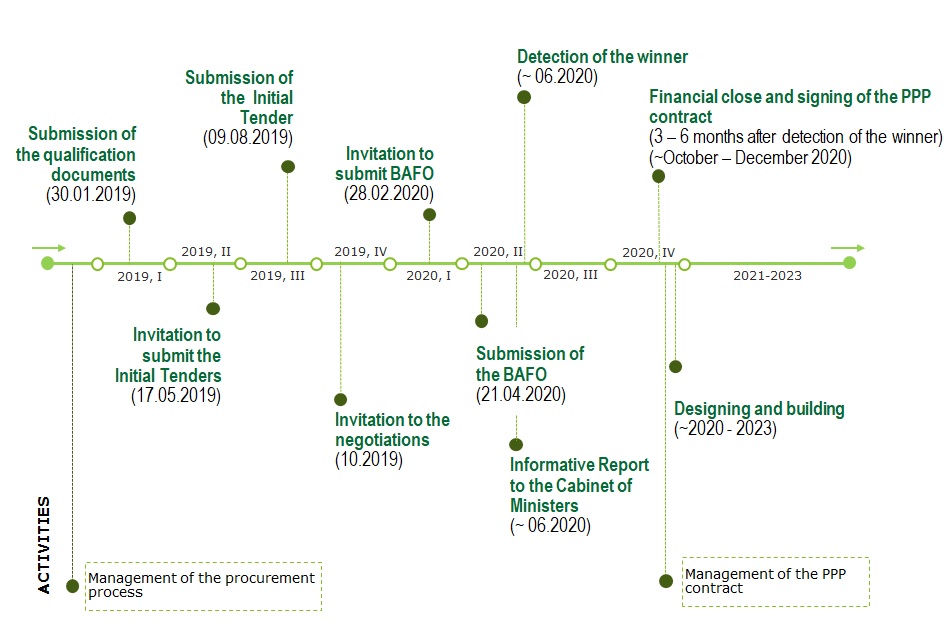Ķekava bypass PPP project
General information about the project
Why Ķekava bypass?
The Ķekava bypass after its construction will be the new section of the road A7 Riga – Bauska – the border of Lithuania (Grenctale) from km 7.9 to km 25.0 and it will be a part of the international road E67 Via Baltica (Helsinki – Tallinn – Riga – Panevežys – Kaunas – Warsaw – Prague). It will be a part of the TEN-T network ensuring the most efficient road connection between the capital of Latvia – Riga and the neighbor country Lithuania as well as the rest of Europe. The road E67 provides traffic stream through Riga city to the bypass of Riga (A4 Baltezers-Saulkalne), the bypass of Riga (A5 Salaspils-Babīte), the road A6 Riga-Daugavpils-Kraslava-the border of Belorussia (Patarnieki), the road A8 Riga-Jelgava-the border of Lithuania (Meitene) as well as the road A9 Riga (Skulte)-Liepaja.
The existing road E67 / A4 in its section Riga – Ķekava has one of the highest volume – capacity ratio in Latvia and the traffic volume has been multiplied several times during the last 15 years exceeding 17 000 vehicles per day. Consequently, already now the planned traffic volume for the existing road construction has been exceeded approximately three times, moreover, this is the only exit out of the Riga city having two-lane carriageway.
Technical characteristic of the planned bypass
The total length of the Ķekava Bypass has been planned 17.5 km including construction of the new high -speed section (14.4 km in total) and reconstruction of the existing road (3.1 km). 11.1 km of them planned as four-lane carriageway and 6.4 km planned carriageway with two lanes. The project includes also four multiple junctions, four tunnels, one bridge, seven roundabouts as well as parallel roads in total length of 14,4 km.
Preconditions of using PPP model
PPP or Private – Public partnership project has been chosen as the most appropriate solution based on the following criteria:
- involvement of the private sector (construction companies, banks etc.) into providing of the public services (in this case, the public partner or client is the Ministry of Transport of the Republic of Latvia),
- high quality road construction within the desired timeframe,
- mutual economic advantage,
- an optimal cost-effective risk distribution,
- innovative management and technologies,
- growth of industry enterprises
Characteristic of the PPP model
The PPP model chosen for construction of the Ķekava Bypass has the following conditions:
- type of contract – DBFM (design, build, finance and maintain),
- the contract duration: 23 years (3 year for technical designing and construction, 20 years for maintenance),
- type of payments to the private partner: availability payments
Planned time schedule of the project implementation

Useful information about the project
The Tenderers whos Initial Tenders have been assessed as meeting the criteria of the Award phase within the procurement procedure “Public – Private Partnership Contract on Designing, Construction, Financing and Maintaining of Section 7.9 – 25.0 km (Kekava Bypass) of Riga – Bauska – Lithuanian Border (Grenctāle)” after Negotiation procedure on 28.02.2020 were invited to prepare and submit their Best and Final Offers (BaFO) in compliance with requirements of the Award criteria. The deadline of submission of the BaFO: 21.04.2020.
—-
On September 4-7, 2018, the International Open Days 2 of the PPP project “Kekava Bypass” took place in Riga in the form of individual Q&A sessions to raise awareness on requirements of the competitive procedure with negotiations including selection and award criteria.
The most important information discussed during the event has been summarized in the following documents:
—-
Please note that the information published in this section of the website may differ from the official procurement documentation and therefore can be used for informative needs only.